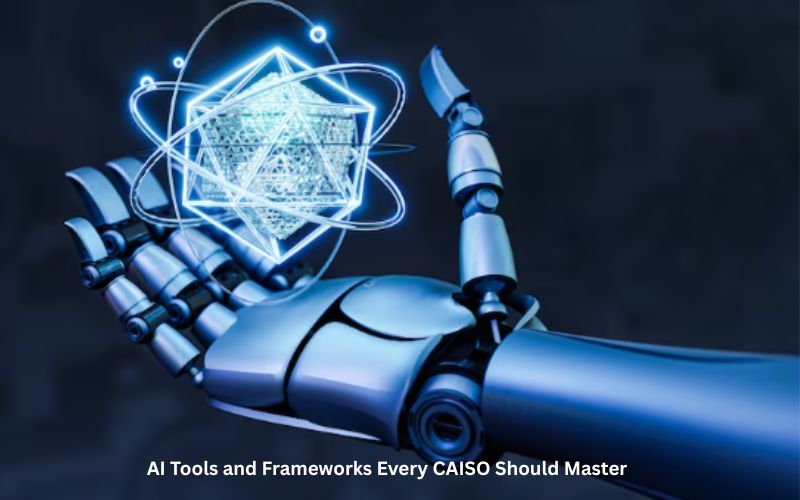As artificial intelligence continues to shape the digital world, securing AI systems has become a top priority. The role of a Certified AI Security Officer (CAISO) is more critical than ever—not just to prevent attacks but to ensure AI is ethical, explainable, resilient, and aligned with compliance standards.
To perform effectively, every CAISO must be equipped with a solid understanding of key AI tools and frameworks that enable governance, security, monitoring, and risk mitigation. This article explores the essential tools and systems a CAISO should master.
1. 🧠 AI Model Development & Monitoring
A CAISO must first understand how AI models are developed and monitored. Familiarity with model training and deployment tools helps identify vulnerabilities early in the AI lifecycle.
- TensorFlow / PyTorch: Leading open-source frameworks for creating machine learning and deep learning models. Understanding their architecture is essential for identifying model-specific risks.
- MLflow: Used to manage the ML lifecycle, including experimentation, deployment, and tracking. CAISOs can leverage this for maintaining auditable records of model evolution.
- Weights & Biases: Helps track experiments and model performance. Ensures reproducibility and supports forensic analysis in case of anomalies.
- ClearML: An orchestration tool for managing ML workflows. Useful for enforcing operational transparency and automation with audit logs.
2. 🛡️ AI Security & Adversarial Defense
AI models are vulnerable to adversarial attacks, where subtle inputs can fool systems into making incorrect predictions. CAISOs must master tools that test and harden models against these threats.
- IBM Adversarial Robustness Toolbox (ART): Enables testing of AI models against adversarial attacks and implements defenses.
- Microsoft Counterfit: A powerful tool for security benchmarking of ML models using automated red teaming techniques.
- Foolbox: A Python-based toolkit that simulates adversarial attacks to assess model vulnerability.
- SecML: Framework for security evaluation of machine learning systems, helping identify and patch exploitable weaknesses.
3. ⚖️ Governance, Bias Detection & Explainability
Ethical and explainable AI is at the heart of AI governance. CAISOs must ensure that AI models are fair, transparent, and accountable.
- AI Fairness 360 (IBM): Identifies and mitigates bias in datasets and models. Helps align with fairness regulations like GDPR and the EU AI Act.
- LIME / SHAP: Popular libraries for explaining black-box model predictions, vital for regulatory compliance and trust.
- Google What-If Tool: Offers a visual interface to explore model predictions and assess fairness and sensitivity.
- Pymetrics Audit AI: Provides audits of AI models used in HR or hiring, ensuring compliance with anti-discrimination laws.
4. 📋 Compliance & Risk Management Frameworks
Frameworks provide the backbone for AI governance. They offer structured approaches for managing AI risks and ensuring regulatory alignment.
- NIST AI Risk Management Framework (AI RMF): A robust U.S. standard outlining how to manage risks throughout the AI lifecycle.
- ISO/IEC 42001:2023: The first global standard for AI management systems. Offers guidance for responsible AI use at the organizational level.
- EU AI Act: A proposed European law categorizing AI systems based on risk levels. CAISOs must be prepared to assess and classify AI systems accordingly.
- OECD AI Principles: Guidelines promoting trustworthy, human-centered AI. Useful for shaping AI policies and ethical standards.
5. 🔧 Infrastructure, Deployment & Monitoring
Securing the infrastructure that supports AI is just as important as securing the models themselves.
- Kubernetes (with KubeSec, Kube-bench): Manages AI workloads. Security tools help harden clusters against attacks.
- Kubeflow: Streamlines ML workflows on Kubernetes. Critical for automating and securing AI pipelines.
- Amazon SageMaker / Azure ML: Popular cloud platforms for AI. CAISOs must ensure configurations follow security best practices.
- Prometheus + Grafana: Used to monitor the health and performance of AI systems. Alerts can be set for unusual behavior, enabling faster incident response.
6. 🧪 AI Threat Intelligence & Auditing
Understanding AI-specific threats and maintaining proper logs for investigation are key for proactive defense and compliance.
- MITRE ATLAS: A threat matrix tailored to adversarial machine learning. CAISOs can use it to map threats and model potential attack paths.
- OpenAI Eval: Assesses language models’ behavior to detect vulnerabilities or misuse potential.
- Apache Superset / ELK Stack: Tools for data logging, visualization, and anomaly detection. Useful for maintaining a clear audit trail and forensic investigations.
Conclusion: Building the CAISO Toolkit
The role of a CAISO requires a multidisciplinary toolkit—spanning machine learning, cybersecurity, governance, and regulatory compliance. Mastering the tools and frameworks outlined in this article ensures that AI systems are not only innovative but also secure, ethical, and resilient.
By staying updated on evolving threats, emerging technologies, and compliance frameworks, CAISOs will remain key players in building trustworthy and responsible AI ecosystems.
Join Our Winning UK Certification on Certified AI Security Officer training





